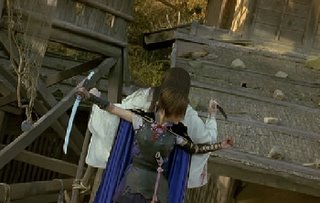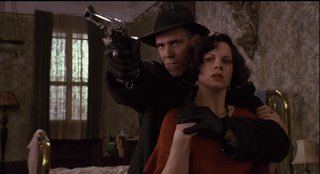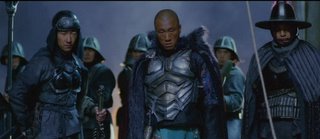Survive Style 5+
 The sound of spade on flesh fills a cold winter night as a man rectifies a simple mistake, trying to bury his victim while she was still alive. The man played by a mesmerising Tadanabou Asano, heads back home, day of the dead dolls dangling from his car's mirror, and discovers his recently deceased wife waiting for him patiently at the dinner table.
The sound of spade on flesh fills a cold winter night as a man rectifies a simple mistake, trying to bury his victim while she was still alive. The man played by a mesmerising Tadanabou Asano, heads back home, day of the dead dolls dangling from his car's mirror, and discovers his recently deceased wife waiting for him patiently at the dinner table.Thus begins Gen Sekiguchi’s series of five interconnected vignettes which focus primarily on Asano’s attempts to kill his seemingly immortal wife, a trio of robbers who like each other a little too much, a narcissistic commercial maker, a salaryman hypnotised into thinking he is a bird and a hitman who growls through his interpreter a simple, but often fatal, question: What is your function in life?
These five stories, told in segments throughout the whole film, cross and collide at several key junctures with characters from different arcs being used in a variety of situations. An example would be the English hitman, played by a scarily convincing Vinnie Jones, who doesn’t actually have his own story, but acts as a catalyst for one story, murdering a hypnotist before he can reverse his hypnotism, and serving as end points for two of the other stories.
 In a lot of ways it’s like Magnolia if Magnolia was technicolour and demented. It’s probably a little lazy calling a film ‘insane’, ‘demented’ or ‘crazy’ but Survive Style 5+ is almost dependant on those verbs. Coming from an advertising background Gen Sekiguchi creates a film that is positively buzzing with surreal energy.
In a lot of ways it’s like Magnolia if Magnolia was technicolour and demented. It’s probably a little lazy calling a film ‘insane’, ‘demented’ or ‘crazy’ but Survive Style 5+ is almost dependant on those verbs. Coming from an advertising background Gen Sekiguchi creates a film that is positively buzzing with surreal energy.What is impressive however is that amidst crazy commercials involving kappa and men with upside down faces, esoteric hit men, reincarnated murder victims with powers relating to how they were previously dispatched, a primary school teacher admonishing children for making boring paintings, Sonny Chiba as an electronics president instructing his wife how to change a light bulb during a meeting, and a father trying to teach himself how to fly there are moments of tenderness.

Survive Style 5+ is truly an anarchic movie but is also craftily designed so that even if characters are little more than ciphers you end up empathising with them by the end of the film. One perfect example of this is Asano’s unnamed character who rarely speaks and frequently murders his wife and yet becomes almost sympathetic by the end of the film. This is of course largely due to another excellent performance by Asano who has the gift of being a perfect physical actor. He can tell you more with the furrow of a brow and the dart of an eye than any other actor could with a 12 page soliloquy.
In fact Survive Style 5+ is blessed with actors who seem to know exactly how to treat the material. While no one will win awards, except maybe Asano, the cast gives the hugely surrealistic film a thematic grounding by playing everything big. The hypnotist Aoyama is a cock thrusting truly over the top monstrosity who is played with such gusto that it’s hard not to connect with him, and the same can be said for all the actors whom just inhabit their characters perfectly.
 The movie seems to be what the medium of film was made for. I don’t think I have seen a film that was as meticulously designed or impeccably sound tracked as Survive Style 5+. The sets and costume designs are simply fantastic with every aspect of the production undergoing the same hyper stylised approach as the story, the standout being Asano’s home a mansion with rooms of various colours and tones which seems to morph, like his reoccurring wife, to suit the situation.
The movie seems to be what the medium of film was made for. I don’t think I have seen a film that was as meticulously designed or impeccably sound tracked as Survive Style 5+. The sets and costume designs are simply fantastic with every aspect of the production undergoing the same hyper stylised approach as the story, the standout being Asano’s home a mansion with rooms of various colours and tones which seems to morph, like his reoccurring wife, to suit the situation.Combined with a soundtrack that is at times overbearingly hilarious, the tale of the three robbers would be monumentally dull if not for the thumping electro pop song that blasts whenever two of them make eye contact, but always perfectly serves the moment, one of the last Asano scenes has a song which perfectly demonstrates his characters desperation and the futility of his efforts to avert the impending situation.
 In all Survive Style 5+ is one of the most stylish films of the new millennium which does have an emotional undercurrent which while not pervasive gives the movie just enough weight to make it a sure fire modern classic.
In all Survive Style 5+ is one of the most stylish films of the new millennium which does have an emotional undercurrent which while not pervasive gives the movie just enough weight to make it a sure fire modern classic.9/10
Notes on the DVD
I watched Survive Style at the cinema first and subsequently ordered the version below
Survive Style 5+
The DVD comes with the movie and a 2nd disc jam packed with features, which are unfortunately not subbed.
The picture quality is stunning, matching the impeccable print I saw at the cinema, and the sound quality is fantastic. While there are occasional glitches with regards to subtitles they are infrequent and amount to little more than “It’s is”.
In all it’s a fantastic package and if you’re thinking of getting a copy I’d go with that.
























 I am talking about the Takeshi Kitano versions here not the utterly awesome series of films that preceeded it...
I am talking about the Takeshi Kitano versions here not the utterly awesome series of films that preceeded it... In the 60s if a samurai in film was a good warrior he was either slightly loony (Sword of Doom)...or an anti establishment figure of sorts (Samurai Assassin, Samurai Rebellion).In the 70s had been stripped to their most base level. The chambara films fading in place of (very popular) brutal films such as Lone Wolf and Cub. It is interesting to note that post September 11th just as super hero films in the west have had a major resurgance so Samurai films in the orient have become the order of the day. Zatoichi being one of several spectacular new films focused on the ancient order.
In the 60s if a samurai in film was a good warrior he was either slightly loony (Sword of Doom)...or an anti establishment figure of sorts (Samurai Assassin, Samurai Rebellion).In the 70s had been stripped to their most base level. The chambara films fading in place of (very popular) brutal films such as Lone Wolf and Cub. It is interesting to note that post September 11th just as super hero films in the west have had a major resurgance so Samurai films in the orient have become the order of the day. Zatoichi being one of several spectacular new films focused on the ancient order.







 Happiness of the Katakuris is actually a remake of a fairly recent Korean film. The original was a dour, painfully unfunny satire about a family who set up a remote guesthouse and find that none of their guest’s can last the night. Faced with a growing number of corpses the family begin burying them out in the surrounding wasteland.
Happiness of the Katakuris is actually a remake of a fairly recent Korean film. The original was a dour, painfully unfunny satire about a family who set up a remote guesthouse and find that none of their guest’s can last the night. Faced with a growing number of corpses the family begin burying them out in the surrounding wasteland.